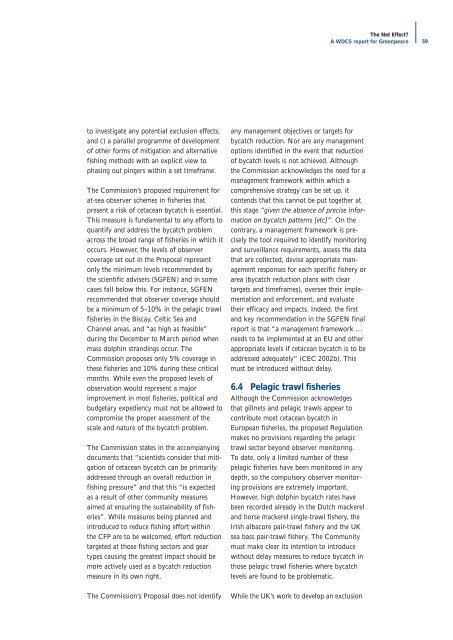The Net Effect? - Whale and Dolphin Conservation Society
The Net Effect? - Whale and Dolphin Conservation Society
The Net Effect? - Whale and Dolphin Conservation Society
You also want an ePaper? Increase the reach of your titles
YUMPU automatically turns print PDFs into web optimized ePapers that Google loves.
to investigate any potential exclusion effects;<br />
<strong>and</strong> c) a parallel programme of development<br />
of other forms of mitigation <strong>and</strong> alternative<br />
fishing methods with an explicit view to<br />
phasing out pingers within a set timeframe.<br />
<strong>The</strong> Commission’s proposed requirement for<br />
at-sea observer schemes in fisheries that<br />
present a risk of cetacean bycatch is essential.<br />
This measure is fundamental to any efforts to<br />
quantify <strong>and</strong> address the bycatch problem<br />
across the broad range of fisheries in which it<br />
occurs. However, the levels of observer<br />
coverage set out in the Proposal represent<br />
only the minimum levels recommended by<br />
the scientific advisers (SGFEN) <strong>and</strong> in some<br />
cases fall below this. For instance, SGFEN<br />
recommended that observer coverage should<br />
be a minimum of 5–10% in the pelagic trawl<br />
fisheries in the Biscay, Celtic Sea <strong>and</strong><br />
Channel areas, <strong>and</strong> “as high as feasible”<br />
during the December to March period when<br />
mass dolphin str<strong>and</strong>ings occur. <strong>The</strong><br />
Commission proposes only 5% coverage in<br />
these fisheries <strong>and</strong> 10% during these critical<br />
months. While even the proposed levels of<br />
observation would represent a major<br />
improvement in most fisheries, political <strong>and</strong><br />
budgetary expediency must not be allowed to<br />
compromise the proper assessment of the<br />
scale <strong>and</strong> nature of the bycatch problem.<br />
<strong>The</strong> Commission states in the accompanying<br />
documents that “scientists consider that mitigation<br />
of cetacean bycatch can be primarily<br />
addressed through an overall reduction in<br />
fishing pressure” <strong>and</strong> that this “is expected<br />
as a result of other community measures<br />
aimed at ensuring the sustainability of fisheries”.<br />
While measures being planned <strong>and</strong><br />
introduced to reduce fishing effort within<br />
the CFP are to be welcomed, effort reduction<br />
targeted at those fishing sectors <strong>and</strong> gear<br />
types causing the greatest impact should be<br />
more actively used as a bycatch reduction<br />
measure in its own right.<br />
<strong>The</strong> Commission’s Proposal does not identify<br />
any management objectives or targets for<br />
bycatch reduction. Nor are any management<br />
options identified in the event that reduction<br />
of bycatch levels is not achieved. Although<br />
the Commission acknowledges the need for a<br />
management framework within which a<br />
comprehensive strategy can be set up, it<br />
contends that this cannot be put together at<br />
this stage “given the absence of precise information<br />
on bycatch patterns [etc]”. On the<br />
contrary, a management framework is precisely<br />
the tool required to identify monitoring<br />
<strong>and</strong> surveillance requirements, assess the data<br />
that are collected, devise appropriate management<br />
responses for each specific fishery or<br />
area (bycatch reduction plans with clear<br />
targets <strong>and</strong> timeframes), oversee their implementation<br />
<strong>and</strong> enforcement, <strong>and</strong> evaluate<br />
their efficacy <strong>and</strong> impacts. Indeed, the first<br />
<strong>and</strong> key recommendation in the SGFEN final<br />
report is that “a management framework …<br />
needs to be implemented at an EU <strong>and</strong> other<br />
appropriate levels if cetacean bycatch is to be<br />
addressed adequately” (CEC 2002b). This<br />
must be introduced without delay.<br />
6.4 Pelagic trawl fisheries<br />
Although the Commission acknowledges<br />
that gillnets <strong>and</strong> pelagic trawls appear to<br />
contribute most cetacean bycatch in<br />
European fisheries, the proposed Regulation<br />
makes no provisions regarding the pelagic<br />
trawl sector beyond observer monitoring.<br />
To date, only a limited number of these<br />
pelagic fisheries have been monitored in any<br />
depth, so the compulsory observer monitoring<br />
provisions are extremely important.<br />
However, high dolphin bycatch rates have<br />
been recorded already in the Dutch mackerel<br />
<strong>and</strong> horse mackerel single-trawl fishery, the<br />
Irish albacore pair-trawl fishery <strong>and</strong> the UK<br />
sea bass pair-trawl fishery. <strong>The</strong> Community<br />
must make clear its intention to introduce<br />
without delay measures to reduce bycatch in<br />
those pelagic trawl fisheries where bycatch<br />
levels are found to be problematic.<br />
While the UK’s work to develop an exclusion<br />
<strong>The</strong> <strong>Net</strong> <strong>Effect</strong>?<br />
A WDCS report for Greenpeace<br />
59

















